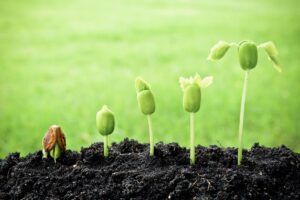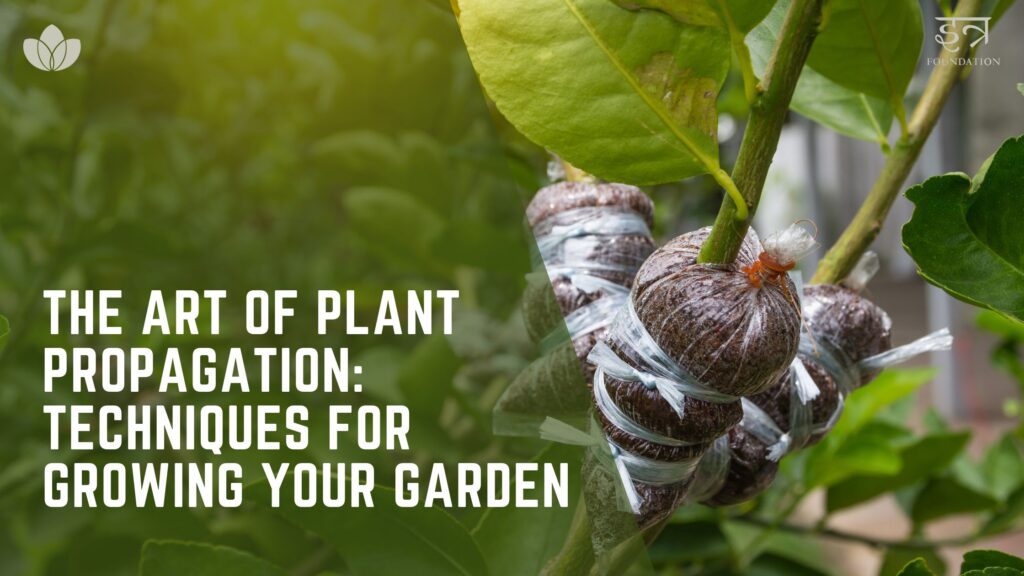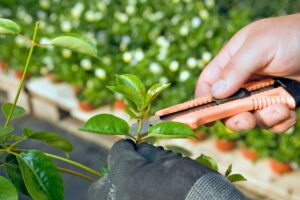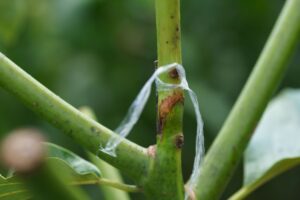Plant propagation is the process of reproducing plants to create new individuals. It is a critical skill for gardeners and horticulturists because it allows them to grow more plants from a single specimen, which can be particularly useful for rare or expensive plants. Additionally, plant propagation can be used to maintain the traits of specific cultivars or to produce plants with desired characteristics. 
There are several methods of plant propagation, including sexual reproduction, asexual reproduction and tissue culture. Sexual reproduction involves the fusion of male and female gametes to create a new plant, while asexual reproduction involves creating new plants from existing plant parts such as stems or leaves. Tissue culture, on the other hand, involves growing plants from tiny pieces of plant tissue in a laboratory setting. Understanding the different types of plant propagation and when to use them is essential for successful gardening and horticulture.
Sexual Reproduction
A. Explanation of sexual reproduction
- Sexual reproduction is a type of plant propagation that involves the fusion of male and female gametes to create a new plant.
- The male gamete is contained in pollen, while the female gamete is contained in the ovule.
- When the pollen lands on the stigma of a flower, it sends a tube down to the ovary where it fertilizes the ovules.
B. Advantages and disadvantages of sexual reproduction
- One advantage of sexual reproduction is that it creates genetic diversity in the offspring, which can be useful in adapting to changing environmental conditions.
- Another advantage is that it can produce offspring with desirable traits for plant breeding.
- However, sexual reproduction can also produce offspring with undesirable traits or genetic defects.
C. Examples of plants that reproduce sexually
- Many common garden plants reproduce sexually, including tomatoes, beans and flowers such as roses, daisies and sunflowers.
- Trees such as oak, maple and birch also reproduce sexually.
D. Steps to propagate plants through sexual reproduction:
- To propagate plants through sexual reproduction, collect seeds from a mature plant.
- Plant the seeds in soil or a growing medium and provide them with adequate light and water.
- The seeds will germinate and grow into seedlings, which can then be transplanted into the garden or container.
Asexual Reproduction

A. Explanation of asexual reproduction
- Asexual reproduction is a type of plant propagation that does not involve the fusion of male and female gametes.
- Instead, it involves creating new plants from existing plant parts such as stems, leaves, or roots.
- This can occur naturally when a plant sends out runners, offsets, or suckers, or it can be induced by gardeners through techniques such as cuttings or layering.
B. Advantages and disadvantages of asexual reproduction
- One advantage of asexual reproduction is that it results in offspring that are genetically identical to the parent plant.
- This can be useful for maintaining the traits of specific cultivars, such as fruit trees that produce a certain type of apple or roses with a specific color or fragrance.
- Another advantage is that asexual reproduction can be faster and easier than sexual reproduction, as it does not require the production of flowers, pollination, or seed development.
- However, a disadvantage is that asexual reproduction does not create genetic diversity in the offspring, which can be a disadvantage in changing environmental conditions or in plant breeding.
C. Examples of plants that reproduce asexually
- Many common garden plants reproduce asexually, including succulents, spider plants and some ferns.
- Fruit trees such as apples, pears and peaches can also be propagated asexually through techniques such as grafting or budding.
- Vegetables such as potatoes, garlic and onions are typically propagated asexually as well.
D. Different types of asexual reproduction
- Cuttings:

- Cuttings involve taking a section of stem or leaf from a parent plant and rooting it in soil or water to create a new plant.
- Types of cuttings include stem cuttings, leaf cuttings and root cuttings.
- Stem cuttings are the most common and involve taking a section of stem with leaves and placing it in soil or water to allow new roots to form.
- Layering:

- Layering involves bending a stem or branch of a parent plant and burying part of it in the soil to create a new plant.
- The buried portion of the stem will develop roots and a new plant will grow from it.
- Types of layering include simple layering, where a branch is buried in soil and allowed to root and air layering, where a stem is wounded and wrapped in moist soil or moss until roots form.
- Division:

- Division involves separating a parent plant into two or smaller plants, each with its own roots and shoots.
- This method is typically used for plants that grow in clumps or have multiple stems, such as hostas or ornamental grasses.
- The plant is carefully dug up and the roots and shoots are divided, then replanted separately.
- Grafting:

- Grafting involves joining two different plants together to create a new plant with desirable traits from both.
- The scion, or top part of the plant, is cut and attached to the rootstock, or bottom part of the plant, through a process called cambium layering.
- This method is commonly used in fruit tree production and can also be used for ornamental plants.
- Budding:

- Budding is similar to grafting but involves attaching a single bud from the scion to the rootstock instead of a larger piece of the plant.
- This method is often used in citrus fruit production and can also be used for roses and other ornamental plants.
- The bud is inserted into a small incision in the rootstock and then wrapped to hold it in place until it grows into a new plant.
Tissue Culture
A. Explanation of tissue culture
- Tissue culture is a propagation method that involves growing plant cells or tissues in a sterile laboratory environment.
- It allows gardeners and horticulturists to produce large numbers of plants that are genetically identical to the parent plant, without the need for seeds, cuttings, or grafting.
- This method involves taking a small piece of plant tissue, such as a leaf or stem and placing it in a nutrient-rich medium to allow the cells to divide and grow into a new plant.
B. Advantages and disadvantages of tissue culture
- One advantage of tissue culture is that it allows for the production of large numbers of plants with consistent quality and genetic makeup.
- This can be useful for producing plants for research or for the commercial production of crops.
- Another advantage is that tissue culture can be used to propagate plants that are difficult or impossible to grow through other methods.
- However, a disadvantage is that tissue culture requires specialized equipment and expertise, making it more expensive and less accessible to amateur gardeners.
C. Examples of plants that are propagated through tissue culture
- Tissue culture is commonly used to propagate orchids, which can be difficult to grow from seeds or cuttings.
- Other plants that are commonly propagated through tissue culture include bananas, strawberries, and many types of ornamental plants.
- Tissue culture can also be used to produce disease-free plants, such as potatoes and grapevines.
D. Steps to propagate plants through tissue culture
- The first step in tissue culture is to select a suitable tissue sample from the plant.
- The sample is then sterilized to prevent contamination by bacteria or fungi.
- The tissue is then placed in a nutrient-rich medium containing plant hormones and other nutrients to encourage growth and cell division.
- Once the cells have multiplied and formed a small plantlet, it can be transferred to a new medium to continue growth and development.
Overall Plant propagation is an important technique for gardeners and horticulturists alike. There are several different methods of plant propagation, including sexual reproduction, asexual reproduction, and tissue culture. Each method has its own advantages and disadvantages, and selecting the best method for a particular plant is important.
Propagating plants can be a fun and rewarding way to expand your garden, but it requires attention to detail and proper care. Successful plant propagation depends on maintaining optimal growing conditions, selecting healthy plant material, and choosing the right propagation method. With practice and patience, gardeners and horticulturists can successfully propagate plants and enjoy the benefits of this important technique.







